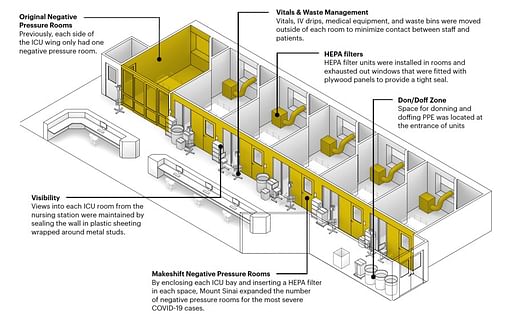

In the mad rush to accommodate the surge of COVID-19 patients in New York City that started in March, the city's Mount Sinai hospital looked to MASS Design Group to help it understand how its built environment could be influencing contagion control, and to gather additional knowledge that could be shared with other hospitals facing a surge in COVID-19 patients .
MASS Design Group has extensive experience working within the pandemic setting, as the group's work in Haiti, East Africa, and other international locales battling infectious disease outbreaks demonstrates. In a recent article published by The Boston Globe, Michael Murphy, founding principal and executive director of MASS Design Group, outlines design approaches focused on the potential spaces have to transmit (or prevent transmission) of deadly particles via "air, surfaces, and water."
MASS Design Group partnered with Ariadne Labs, a healthcare innovation consultancy founded by Atul Gawande, to publish an online PDF titled Redesigning Hospital Spaces on the Fly to Protect Healthcare Workers that offers insights into the approaches implemented at Mount Sinai.
The nine-page document, which is not meant to be a design guide but aims to reflect the new understandings MASS Design Group developed of the course of their work, states, "Until we can better understand the virus’ pathways, we won’t be able to confidently redesign our existing spaces to adhere to new and higher standards of infection control guidelines."
The document adds, "In the meantime, hospitals will continue to repurpose and convert their spaces adhoc to meet surge demand—adapting idealized infection control protocols to unideal spaces and situations. This means healthcare workers and administrators must quickly adapt inflexible spaces, recognizing that the resulting adaptations may put healthcare workers and our communities at risk unless we can quickly create site-specific guidelines that are adherable and implementable based on the best available knowledge."
In the case of Mount Sinai, the group worked to retrofit conventional hospital spaces, which contained a select number of rooms and spaces dedicated to infectious disease control, for wholesale use as an infectious disease clinic. This approach required creating large negative pressure entry zones to prevent the spread of pathogens from where COVID-19 patients were being held to other areas.
Mount Sinai also deployed wayfinding and graphic design approaches, including adding red tinted plastic to entry doors and painting spaces and the areas around doorways in different colors, to indicate where highly infectious areas were present. Describing the scope of work, the document explains that "researchers, and designers came together to understand the constraints of adapting guidelines to imperfect spaces, and the lessons we believe other institutions can learn from this."

Some of the team's findings include:
In addition, Mount Sinai converted an existing atrium in the hospital for temporary medical use as a "step down care" facility for those who had recovered but were not strong enough to be discharged yet.
The project hints at some of the coming changes that might take shape within hospital settings and other so-called "alternate care sites" in the United States, which could see a slew of design and functional modifications over the near-term due to the pandemic and any possible second or third "waves" of infections that could materialize over coming months.
No Comments
Block this user
Are you sure you want to block this user and hide all related comments throughout the site?
Archinect
This is your first comment on Archinect. Your comment will be visible once approved.